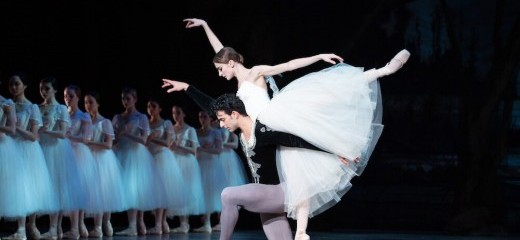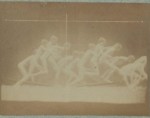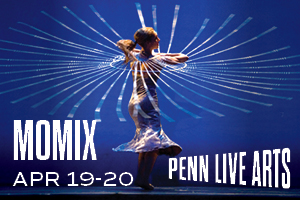
Maslova’s Magnetic Giselle
by Lynn Matluck Brooks
Taking on Giselle is no light matter. The lead character goes through a rapid succession of dramatic states: a naïve and playful peasant girl, a weak-hearted invalid, a furious madwoman repelling an entire village gathered in anguish around her, a wraith bound to her sister spirits and their merciless leader, a lover so faithful that even the grave can’t restrain her tenderness. That’s no small order, as former tD writer Julie Diana explained, for one ballerina to pull off in the course of a couple of hours. Added to that is the work’s history as one of the most-performed and best-loved ballets of all time, one in which the leading terpsichorean lights of many generations have made their mark—Carlotta Grisi (for whom the ballet was created in 1841), Anna Pavlova, Alicia Markova, Carla Fracci, Diana Vishneva, and so many other great ballerinas.
Angel Corella, artistic director of Pennsylvania Ballet, deems the current company up to the challenge, opening the ballet’s run with principal dancers Oksana Maslova as Giselle and Arian Molina Soca as her princely betrayer, Albrecht. The company has presented this ballet over the years, allowing new generations of dancers to take on these iconic roles and new generations of audiences to experience the work’s power. PAB’s staging is traditional, presenting Giselle’s cottage on stage right, balanced by the stage-left shed where Albrecht hides his princely gear for his disguised dalliance with the pretty peasant girl. The background (scenes by Peter Cazalet) reveals a romantically idealized landscape of trees, waterways, and a hill topped by the castle from which Albrecht and retinue presumably emerge. Villagers are dressed in attractive earthy tones, while the royalty who flit onto the scene flash brilliant jewel-toned robes (costumes by David Huevel). The choreography to Adolphe Adam’s lilting music is credited, for this run, to “Angel Corella, after Jean Coralli & Jules Perrot,” the work’s original choreographers.
In her powerhouse performance of Giselle on opening night, Maslova, diminutive in size but big in her emotional projection, revealed a delicious delicacy, shy but impassioned. This Giselle chose to dance—weak heart or no—just as she chose to commit her heart where she would. Alas, that was to the prince, “slumming” in his own peasant-ish garb. As Albrecht, Molina Soca had fun luring Giselle into their flirtation, skipping along with the villagers, and showing off aerial feats. But soon, he let us know that his heart was drawn to Giselle’s more than he had intended. Her disillusionment, when his betrayal was revealed (he was already betrothed to a lady of his class), was complete: Maslova embodied madness in appearance, hair flying loose and make-up smeared, and in movement, echoing her flirtatious dance with her lover, spinning in fury at her fate, and collapsing to the floor in limp submission to her broken heart. I believed her; Molina Soca, mourning at Giselle’s feet as her mother rocks her dead daughter in her arms, stirred my tears.
Before moving to act 2, I must commend the brilliant first-act “peasant pas de deux” by company soloists Nayara Lopes (what balances!) and Albert Gordon (what spins and leaps!), who stimulated a rousing audience ovation. These two shooting stars will, I hope, long brighten PAB’s horizon.
In the second act, the wilis—affianced maidens who die before their wedding days—flitted in wraithlike precision through their maneuvers, guided by their robotic leader, Myrtha. As Myrtha, Dayesi Torriente’s tense embodiment—stiff shoulders and forward-jutting head—detracted from my belief in her spiritual command of the scene. In contrast, Maslova’s gently loving persistence, even as a newly inducted wili, kept her just floating above the earth, while Molina Soca tuned his body, as well as his soul, to this vision of enduring love, dancing himself not to death—as the wilis commanded—but to purification as the bells chimed the dawn that released him from the spirits’ power and from the consolation of Giselle’s almost-palpable love. I always feel badly, watching this act, for the hapless Hilarion, convincingly danced by PAB favorite Ian Hussey, the peasant lad who faithfully loved Giselle, despite her disinterest in him, and who does succumb to the wilis’ death grip.
In the program booklet’s defensive essay, “Why Giselle?,” PAB Ballet Master Charles Askegard asserts that the ballet owes its endurance to the powerful women it presents, including Giselle herself, and to the ever-current message of forgiveness as a force to heal our world. He may be right, but for me, Giselle works because the romantic value of love defeating even death pierces to the heart of my own worldly anguish: Giselle gives me hope that individual will and persistence of heart can endure as saving graces of afflicted and bewildered humanity.
Giselle, Pennsylvania Ballet, Academy of Music, March 7–17
By Lynn Matluck Brooks
March 9, 2019






.png)


